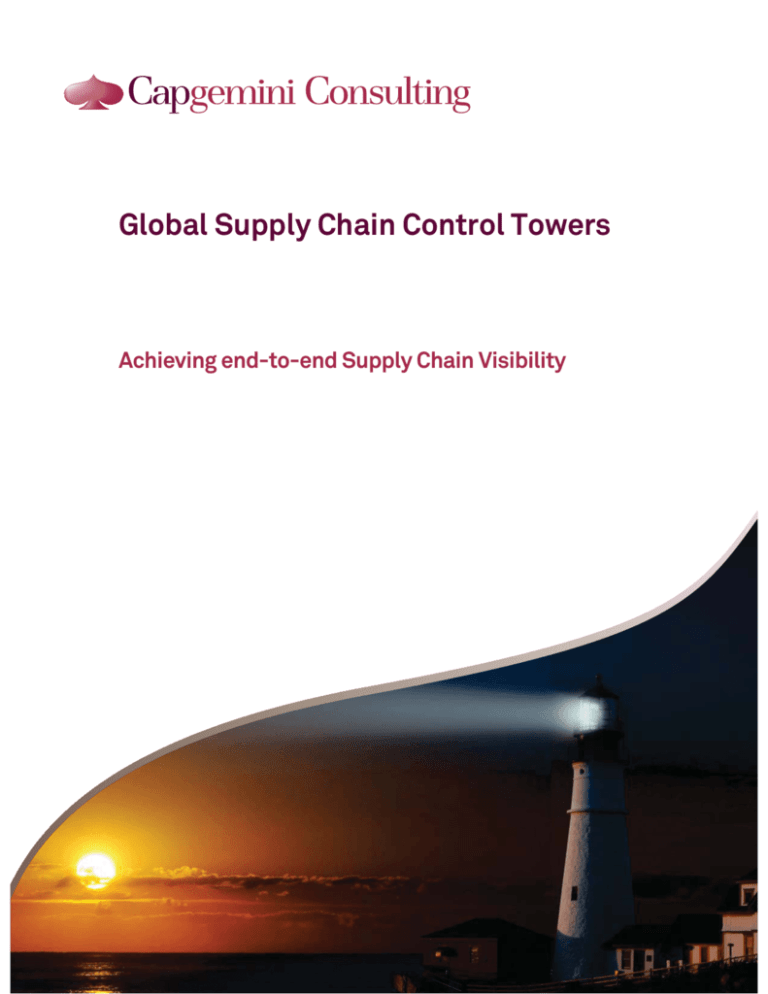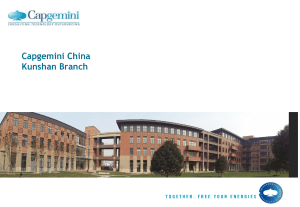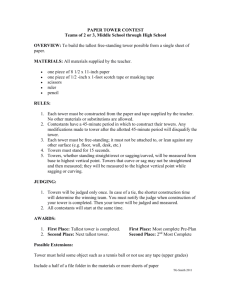
Global Supply Chain Control Towers
Cove
Cov
C
ove
ov
o
vve
errr-Re
r-R
--Re
Re
R
effe
fere
ere
er
e
r n
nce
nc
ce
c
e Nu
Nu
um
mber
Achieving end-to-end Supply Chain Visibility
GLOBAL
OB L
CONTROL
TOWER
Prepared and edited by:
Gaurav Bhosle
Capgemini Consulting India
Prashant Kumar
Capgemini Consulting India
Belinda Griffin-Cryan
Capgemini Consulting USA
Rob van Doesburg
Capgemini Consulting Netherland
MarieAnne Sparks
Capgemini Consulting France
Adrian Paton
Capgemini Consulting UK
L
C o nte nts
4
5
8
12
Introduction
Current state and challenges in Supply Chain Visibility
Understanding Control Towers
Setting up a Control Tower
Introduction
Today’s competitive business
landscape and ever evolving
customer demands are re-shaping
traditional supply chains. First and
foremost, Globalization is increasing
supply chain complexity, as
physical supply chains extend their
geographic scope in order to
leverage low cost sourcing options
and gain access to emerging
markets. The movement of
manufacturing facilities near to the
key markets is also increasing
supply chain complexity. And,
outsourcing is taking the supply
chain outside the four walls of an
organization meaning collaboration
with partners becomes imperative
for supply chain effectiveness.
In addition to the complexities
brought by globalization there is
continuing pressure in most
organizations to increase revenues
and profit margins. These critical
business challenges are driving the
need to focus on creating strong
end-to-end Supply Chain Visibility
capabilities.
Supply Chain Visibility is the key
enabler for managing a business
both within the organizational
boundaries as well as across the
boundaries. This visibility provides
speed, reliability and flexibility in
order to gain a competitive
advantage in the form of well
controlled and managed supply
chain functions. In response to the
need for Supply Chain Visibility,
the leading Supply Chain Visibility
principles are increasingly being
embodied in Supply Chain Control
Towers. A supply chain control
tower is a central hub with the
required technology, organization
and processes to capture and use
supply chain data to provide
enhanced visibility for short and
long term decision making that is
aligned with strategic objectives.
Current state and
challenges in Supply
Chain Visibility
Supply Chain Visibility
Supply Chain Visibility is all about
how organizations capture and
interconnect data to extract critical
supply chain execution information.
It provides a single view for
tracking information, material and/
or cost by monitoring key
dimensions in a global supply
chain, such as inventory positions
or shipment in-transit status and
real-time order movements in order
to make informed and fact based
decisions.
Delivering Supply Chain Visibility
means measuring and controlling the
effectiveness of the overall supply
chain in four key areas (Figure 1Source: supply-chain-visibility.com):
1 - agility, defined as the capacity
to change supply chain processes,
goals, partners, facilities, and other
tangible aspects with minimal delay or
unwanted impact.
2 - resilience, which is defined as
the capacity to withstand unknown
and uncontrollable events with
Total Supply Chain Effectiveness
Service
Cost
Agility
Resilience
Reliability
Responsiveness
The Black Box of
Visibility Processes
Figure1: Supply Chain Effectiveness
minimal impact, to operations
whether in terms of magnitude or
duration.
3 – reliability, which measures
the capacity to meet commitments
on quality, timeliness, cost,
availability, service level, etc. which
is a basic requirement of supply
chain effectiveness.
4 – responsiveness, defined as
the capacity to capture information
and adapt to changes in the
environment including changes in
demand, capacity, regulations, the
competitive environment, or any
other aspect which has the potential
to impact business value.
Phases in Supply Chain
Visibility Transformation
Many organizations have already
implemented or are in the process
of implementing Supply Chain
Visibility solutions. However, these
solutions reflect different levels of
maturity. The maturity level of a
particular visibility solution is
defined by the associated tools,
processes and skills of the people
involved and generally will fall into
one of three phases. As might be
expected, each phase reflects a
higher level of maturity than the
previous one.
Phase One - At the most
rudimentary level, the focus is on
achieving operational level visibility
on supply chain data such as
shipment and inventory status. The
scope of the solution is usually
limited to one or two processes,
such as either outbound or inbound
logistics depending on the strategic
importance of one or the other. The
tools focus on collecting data. The
capabilities of staff are very much
on operational level.
Phase Two - The second phase
focuses on following the status of
shipments across multiple supply
chain nodes and tracing the
problems occurring in between. The
scope includes all the processes
related to inbound and outbound
logistics. The tools provide alerts
for exceptions and events. These
applications are incorporated with
some basic reporting and analytics
capabilities and a knowledge bank
for decision support. The
organization and supporting staff
has capabilities to pro-actively act
upon (potential) issues in the
supply chain.
Phase Three- The third
(advanced) phase, known as
predictive visibility, focuses on self
learning algorithms to predict the
potential problems and generate
alarms for upcoming events. These
solutions are gaining popularity by
providing proactive monitoring of
supply chain functions and helping
with decision support systems. This
type of visibility is useful in the
short term, assuming the operations
provide the real time information.
Such visibility also enables
improved planning capabilities and
allows shippers to make better
tactical or strategic decisions on
optimization of the supply chain.
Leading Practices in Supply
Chain Visibility
Successful Supply Chain Visibility
solutions are deployed around five
leading practices which enable an
organization to achieve an end-toend view of inbound and outbound
operations:
1. Create an ‘Information Hub’ –
integrate and aggregate key
information from inside and
outside the enterprise such as key
order, shipment, and inventory
information from all internal ERP,
TMS, WMS and other inventory
planning systems
2. Track landed costs along the
chain – reduce total landed costs
by tracking product, freight and
insurance costs as well as
integrating trade compliance
information such as duties, tax,
VAT and other governmental
charges
3. Manage trading partners with
scorecards – use a repository of
supply chain data and develop
scorecards to manage supplier
compliance, or transportation
booking performance etc. to
continuously improve global
operations
4. Achieve organizational buy-in
– gain the CFO and finance
organization’s support by
extending the visibility solution to
include financial settlement and
financing triggers
5. Devise a risk management
framework – configure visibility
tools and solutions for SarbanesOxley (SOX) risk mitigation and
disaster recovery in order to
recover effectively from risk
related events
These leading Supply Chain Visibility
practices are the key in gaining an
efficient end-to-end supply chain
view. These can most effectively be
achieved with an integrated Control
Tower solution that includes having
the right people chosen and trained to
act upon the data provided. A large
number of leading organizations have
adopted this approach and have been
able to successfully reap the benefits,
giving them more control over their
market reach.
Understanding
Control Towers
Control Towers are cross-divisional
organizations with system integrated
“information hubs” that provide
Supply Chain Visibility. These hubs
are used for gathering and distributing
information, and allow people trained
to use these visibility capabilities to
detect and act on risks or
opportunities more quickly. Control
Towers are typically set-up to
monitor, measure and manage
transport and inventory movements
across the supply chain.
As shown in figure 2, Control towers
combine organizations (people),
systems and processes in order to
s
De
n
ig
Strategic – provides control over
the design of the overall supply chain
network
Tactical – enables proactive
planning of procurement, operations
and distribution according to market
demand
Operational – encompasses
various real time functionality
including transportation management,
inventory tracking and exception
management
People
Provides expertise for planning,
execution and optimization of
product movements
an
provide supply chain partners with a
high level of product visibility along
the entire supply chain. This enables
three levels of management control:
d
ru
n
Process
Harmonized processes for managing
control tower functions
Figure 2: Three Pillars of Control Towers
Le
ve
ra
ge
s
es
oc
r
p
te
ch
no
lo
gi
es
Technology
Incorporated and driven
by technology
Information repository with data analytics
and decision support functionalities
Getting the technology aspect right is
fundamental to the overall success of
the control tower concept. As shown
in figure 3, while setting up a Control
Tower, different systems are
integrated with each other with the
help of common middleware software
and all information is gathered at a
centralized location. This information
is then used for auditing, monitoring
and taking effective decisions.
Every product ordered from a
supplier; every shipment shipped to a
customer; every document created;
every cost accrued; and every event
generated in the flow of product from
order to final delivery is captured,
organized and stored in the tower.
In-transit inventory at the part/SKU
level can also be captured by the
Control Tower.
This way a rich store of valuable
supply chain information is created,
enabling end-to-end control of a
customer driven supply chain.
Figure 4 shows some of the additional
functionality that Control Towers
provide. Control Towers provide
unprecedented supply chain flexibility
for dynamic planning and routing.
Control Towers allow the generation
of reports that shows the total landed
Organization
for monitoring
and decision
making
Set up of a
Virtual Network
Process
Collaboration
and System
Integration
Individual
System
Individual
Processes
r
we
o
t
l
ro
nt
o
C
to
d
e
ct
ne
n
Co
Centralized
information
gathering and
monitoring
Co
nn
ec
ted
to
Co
ntr
ol
tow
er
Set up a Middleware software/ system integration platform
ERP/TMS/WMS
ERP/MES
Inbound
process
Manufacturing
process
Figure 3: Control tower Technology Approach
ERP/TMS/WMS
Outbound
process
cost of every product ordered,
including a breakdown by cost,
category and also showing how these
costs have fluctuated over time. This
data can be used to make predictions
at the daily “operational” level and to
predict supply chain costs. Control
Towers can also accurately predict
ETAs (Expected time of arrivals)
based on what is actually happening
in areas of the supply chain that are
not always so easy to see.
In order to provide this functionality
Control Towers often utilize virtual
network organizations. Consequently,
the establishment of a Control Tower
usually results in the creation of new
roles at different levels in the
organization which work together
towards capturing and monitoring the
process flows at each stage and
standardizing operational practices.
A Control Tower can be customized
according to the specific organization’s
needs in terms of their geographic
reach, scope, functions, processes and
industry type.
In order to successfully implement a
Control Tower, however,
organizations need to carefully think
through a few vital decisions when
setting-up their Control Tower. These
decisions include:
Function of
Control Tower
Planning and
Routing
Auditing and
Reporting
Provides
unprecedented
supply chain
flexibility for
dynamic planning
and routing
Helps in Auditing
all the stages in
detail within the
supply chain
movement
Provides GPS
tracking, Freight
Forwarding and
inventory control
Generate a report
that shows the total
landed cost of every
product with the
breakdown
Figure 4: Function of Control Tower
Forecasting
Event
Management
Make predictions
at the daily
“operational” level,
about ETAs
Provides event
management at all
stages within the
supply chain
Forecast Supply
chain cost and
demand
Provides
Warehouse Mgt,
Transport Mgt, Yard
Mgt, Container Mgt
and billing and
invoicing
Decision
making
Provides a one –
stop-shop solution
with centralized
accountability and
responsibility for
cost, quality and
performance by
creating decision
making platform
Deciding on the goals and
objectives of Supply Chain
Visibility
Identifying the list of functions,
processes or departments to be
monitored
Determining the new
organizational design
Identifying which functions or
processes can be run
collaboratively or outsourced
Deciding the technology solution
to be implemented and
potentially selecting a
solution provider to build the
Control Tower
"SFBPG#FOFöUT
Deciding whether to outsource
the Control Tower operation or
manage it in-house
While some of these decisions may
be complex, if done correctly, the
resulting Control Tower will yield
important cross-functional benefits
that ultimately also benefit end
customers and provide the
organization with a long-term
competitive advantage. A
comprehensive list of these benefits
is shown in the list below:
-JTUPG#FOFöUT
General
t*OUFHSBUFE4VQQMZ$IBJOXJUIBOBCJMJUZUPSFUSJFWFJOGPSNBUJPO
t3FEVDFEDPNQMJBODF1FOBMUJFT
t*NQSPWFEFDJTJPONBLJOHDBQBCJMJUJFT
t3FEVDFEOFUXPSLGBJMVSFTJODSFBTFEOFUXPSLWJTJCJMJUZBOESFTQPOTJWFOFTT
t3FTQFDUDVTUPNFSDPNNJUNFOUTDIFEVMFDPTUTRVBMJUZBOE*NQSPWFEDVTUPNFSTBUJTGBDUJPO
Inbound
t0QUJNBMJOWFOUPSZMFWFMTBOESFEVDFECVòFSJOWFOUPSZ
t4ZOFSHJFTJOQSPDVSFNFOUUSBOTQPSUDBSSJFSTMFBEJOHUPSFEVDUJPOJO5SBOTQPSUBUJPO&YQFOTF
t3FEVDUJPOJOUPUBMMBOEFEDPTUTJODSFBTF0O5JNF*O'VMMEFMJWFSJFT
t)FMQTUPDIBOHFTPVSDJOHTUSBUFHJFTTIJGUTVQQMJFSBMMPDBUJPOTNPEJGZDPNNFSDJBMUFSNT
SFFOHJOFFSBMPHJTUJDTQSPDFTTPSTXBQPVUBMPHJTUJDTQBSUOFS
Manufacturing
t"XBSFOFTTPG8*1JNQSPWFEQSPEVDUJWJUZ
t.BOVGBDUVSJOHJOPQUJNBMXBZPWFSQMBOUTPQFSBUJOHHMPCBMMZ
t.PSFBDDVSBUFEFNBOEQMBOOJOHCFUUFSTDIFEVMJOHSFEVDUJPOJODZDMFUJNFTSFEVDFE
JOWFOUPSZMFWFMTBOEUJNFMZBOEDPNQMFUFNBOBHFNFOUJOGPSNBUJPO
Outbound
t*NQSPWFEMPBEFóDJFODZJO0VUCPVOE
t*NQSPWFUSBOTQPSUFóDJFODZVTJOHCFTUJODMBTTDBSSJFSTBOESFEFTJHOJOHUSBOTQPSUTPMVUJPOT
t"CJMJUZUPQSFEJDUSJHIU&5"GPSDVTUPNFST
Setting up a Control
Tower
In order to successfully set-up a
Control Tower and ultimately achieve
the desired visibility, companies need
to follow a proven approach. A two
stage methodology to set-up an end-toend Control Tower solution that can
be tailored to an organization’s specific
scope, functions, processes, industries
and geographic needs, such as
Capgemini’s Control Tower approach
(as shown in figure 5), has proven very
useful in effectively setting up Control
Towers. Such an approach usually
consists of two distinct stages a
(1) Strategic stage and an
(2) Implementation stage.
Strategic stage
The Strategic stage, generally entails
assessing the As-Is business, capturing
the Supply Chain Visibility needs and
evaluating the benefits (including
financial) which a control tower could
provide. Areas for collaboration with
subcontractors, vendors and partners
within the value chain are identified.
Once the scope of the Control Tower
set-up is finalized, it is important to
understand existing internal systems
and the systems of identified
collaboration partners. After gaining a
thorough understanding of the
requirements, a high-level To-Be
concept for the organization, processes,
in/outsourcing and systems is
designed. The plan is then shared and
signed off with the key stakeholders,
along with the detailed roadmap for
setting-up the Control Tower. This
stage usually lasts for 8 to 12 weeks.
Implementation stage
During the Implementation stage, the
high level Control Tower architecture
is designed. The most suitable
middleware software solution to be
implemented is identified which
considers the current system set-up
and visibility need. The selected
solution should also help the
organization to integrate all its
processes and capture the information
centrally. Following approval of the
selected solution, end-to-end system
integration proceeds on a phase by
phase basis. Once the systems are
completely integrated, testing is done
and a Business Continuity Plan to
support any system failure is
developed.
Once the Control Tower network is
validated, different roles in the virtual
Control Tower organization are created
and developed. Training in how to
generate and interpret different kinds
of reports and track the movements
within the supply chain is conducted
and Control Tower managers are
coached in how to conduct process
level auditing, planning and
predictions based on the available
information. Finally a regular
monitoring mechanism at each stage
within the supply chain flow of the
organization is established. This stage
takes 6 to 12 months.
.
Stage 1
8 to 12 weeks
Stage
Objective
Deliverables
Strategy
Stage 2: Implementation
6 to 12 weeks
Design
Implement
Run
Assess As-Is current
supply chain visibility,
improvement areas
and way forward
Design of organization,
processes, systems to
improve SC visibility
Implement organization,
processes, systems to
improve SC visibility
Run and/or optimize
organization, processes,
systems to improve
SC visibility
t"T*T"TTFTTNFOU
t%FTJHOPGIJHIMFWFM5P
Be concepts for
organization, processes,
in/outsourcing and
systems
t2VJDLXJOT
t1SPKFDUQMBO
t#VTJOFTTDBTF
t0SHBOJ[BUJPOEFTJHO
t1SPDFTT%FTJHO
t4ZTUFNTBSDIJUFDUVSF
t4FMFDUJPOPG*5TPMVUJPO
t4FMFDUJPOPG
outsourcing partner
(when applicable)
t*NQMFNFOUBUJPOQMBO
t1SPKFDUNBOBHFNFOU
t*NQMFNFOUFE
organization
t*NQMFNFOUFEQSPDFTTFT
t*NQMFNFOUFETZTUFNT
t#VTJOFTTQSPDFTT
outsourcing
t4$WJTJCJMJUZ
optimization
CFODINBSLJOH
t*OUFSJNNBOBHFNFOU
Figure 5: Capgemini’s methodology to set-up a Control Tower
Case study: Samsung achieves improved visibility through
Control Tower implementation
Samsung, with a presence in 24 locations and with more than 11,000 staff in Europe,
has outsourced warehouse and distribution activities to multiple logistic service
providers. The fragmented landscape of these LSP’s added complexity to the supply
chain optimization effort. Capgemini helped Samsung to develop end-to-end supply
chain control mechanisms to improve efficiency and reduce costs by using best-in-class
carriers and reduce dependence on their LSP’s. Moreover, Capgemini developed
Samsung’s capabilities to manage activities on the tactical level (e.g. carrier
management, high level planning, contracting) by deploying a Control Tower solution.
An integrated organization was implemented for planning and controlling the IT
product flow from Port-to-Customer. A buying function for procurement and
contract management of logistics and warehousing services was developed. A new
administrative organization was designed in such a way that all required cost data
is captured automatically and can be reported without manual intervention and
delays. Additionally, carrier (selection, evaluation, invoicing) and inbound
(terminal planning, customs status) integration was achieved.
Visibility tool
Control Tower
Management
Order control/CS
Team leader
Transport planning
Team leader
Control
Team leader
Development
Team leader
Region1
Region1
Warehouse
Control
Quality
Region2
Region2
POD
Logistic
Engineering
Region3
Region3
Claims
L2support
Operations inbound
team leader
Cost control
Inbound
Carrier
Management
Control Tower Organization
The solution deployed by Capgemini is helping Samsung to build an efficient and
integrated organization to increase load efficiency, improve tracking and customer
service and enhance transport efficiency using best-in-class carriers and
redesigned transport solutions.
®
About Capgemini Consulting and Capgemini
Capgemini Consulting
is the Global Strategy and
Transformation Consulting brand of
the Capgemini Group, specializing in
advising and supporting organizations
in transforming their business,
from the development of innovative
strategy through to execution, with a
consistent focus on sustainable results.
Capgemini Consulting proposes to
leading companies and governments a
fresh approach which uses innovative
methods, technology and the talents of
over 3,600 consultants worldwide.
For more information:
www.capgemini.com/consulting
Rightshore® is a trademark belonging to
Capgemini
Capgemini, one of the world’s foremost
providers of consulting, technology and
outsourcing services, enables its clients
to transform and perform through
technologies. Capgemini provides its
clients with insights and capabilities that
boost their freedom to achieve superior
results through a unique way of
working, the Collaborative Business
ExperienceTM. The Group relies on its
global delivery model called
Rightshore®, which aims to get the right
balance of the best talent from multiple
locations, working as one team to create
and deliver the optimum solution for
clients. Present in 40 countries,
Capgemini reported 2010 global
revenues of EUR 8.7 billion and employs
over 112,000 people worldwide.
More information is available at
www.capgemini.com.
Headquarters
40 Holborn Viaduct
London EC1N2PB
United Kingdom
Tel.:+44(0) 20 7936 3800
Capgemini Consulting is the strategy and transformation consulting brand of Capgemini Group
The information contained in this document is proprietary. Copyright © 2011 Capgemini. All rights reserved.
©Capgemini Consulting - May 2011
Rob van Doesburg
Global Lead Logistics and Fulfillment GTM
Tel.: +31 30 689 8514
Mob.: +31 6 22 667 910
Email: rob.van.doesburg@capgemini.com
www.capgeminiconsulting.nl









